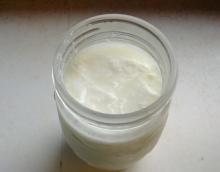Another stop on my quest to reduce my grocery bill was making my own yogurt. Smoothies are a great way to get a good portion of fresh fruit and protein, but that much yogurt can get really expensive! Plus, my county doesn't have recycling for big plastic yogurt tubs, but we can recycle plastic one gallon milk jugs. Less packaging, less money, fewer additives - and it's really simple!
The basic procedure for making yogurt is to scald milk, cool it and mix in some yogurt to serve as a culture, then hold it in a warm place overnight for the culture to propagate. Super easy!
First, the milk. I have read that 2% works better than either skim or whole milk. That has certainly been my experience so far. And ultra-pasteurized milk works fine - maybe even better than normally pasteurized milk. (Ultra-pasteurized milk has a "use by" date of four to six weeks, whereas normally pasteurized milk is good for one or two weeks.)
About the texture. Store-bought yogurt includes gelatin or pectin to help it set, and make it artificially stiff. Homemade yogurt tends to be a lot creamier and looser. (This is great for smoothies!) One way to make your yogurt turn out thicker is to add some powdered milk to the mix.
Keeping the culture warm overnight is the hardest part. It will need to be at least 90 degrees, but not over 100 degrees. If it's too hot, it will kill the bacteria. If it's too cold, the bacteria won't culture.
I used a thermometer and found that my oven will stay at 95 degrees if I leave the light on and the door closed. If you have a gas stove, you may be able to set the yogurt on the warm spot on the stove top, or inside the oven. People have also successfully used a cooler filled with warm water, food dehydrators, sunny spots on the windowsill, crock pots, and even a heating pad inside a bucket. Anything that can maintain that specific temperature range for 12 hours will work fine!
Other equipment you will need is a meat or candy thermometer (ideally a clip-on model), a pot big enough to scald half a gallon of milk, large glass or plastic containers to hold the yogurt, and one small container to hold your new culture.
INGREDIENTS - this makes about 2 quarts of yogurt.
A half gallon of 2% milk
1/2 cup powdered milk
1/2 cup plain yogurt, unopened
DIRECTIONS
1. Pour the milk into a big pot, and whisk in the powdered milk. Heat it over medium-high heat to 185 degrees, stirring almost constantly to keep the milk from scorching at the bottom.
2. Cool the milk to 120 degrees, using an ice or cold tap water bath. The kitchen sink works well for this.
3. Whisk the yogurt into the scalded milk, making sure to blend it in completely.
4. Pour the yogurt into your clean containers. Pour about 8 ounces of the mix into your smaller container. (This will be what you use to culture the next batch, so be sure it doesn't get eaten!)
5. Cover the containers loosely, and place them in a warm spot. Keep the containers between 90 and 100 degrees for about 12 hours, until the yogurt has set.
6. Refrigerate the yogurt for at least 12 hours, until chilled.
